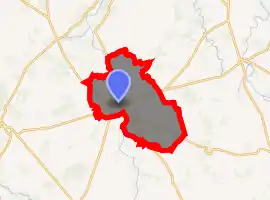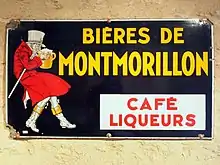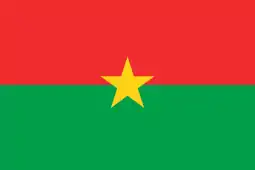Montmorillon
Montmorillon (French pronunciation: [mɔ̃mɔʁijɔ̃]) is a commune in the Vienne department, in the Nouvelle-Aquitaine region, in central-western France. Montmorillon is a Book town and it is branded as the "City of Writing". The town has several writing-inspired museums and bookshops covering several genres.
Montmorillon | |
|---|---|
Subprefecture and commune | |
 The town hall in Montmorillon | |
.svg.png.webp) Coat of arms | |
Location of Montmorillon 
| |
 Montmorillon  Montmorillon | |
| Coordinates: 46°25′37″N 0°52′18″E | |
| Country | France |
| Region | Nouvelle-Aquitaine |
| Department | Vienne |
| Arrondissement | Montmorillon |
| Canton | Montmorillon |
| Government | |
| • Mayor (2014–2020) | Yves Bouloux |
| Area 1 | 57 km2 (22 sq mi) |
| Population (2017-01-01)[1] | 5,954 |
| • Density | 100/km2 (270/sq mi) |
| Time zone | UTC+01:00 (CET) |
| • Summer (DST) | UTC+02:00 (CEST) |
| INSEE/Postal code | 86165 /86500 |
| Elevation | 82–168 m (269–551 ft) (avg. 105 m or 344 ft) |
| 1 French Land Register data, which excludes lakes, ponds, glaciers > 1 km2 (0.386 sq mi or 247 acres) and river estuaries. | |
History

The town was once known for paper making, but in the nineteenth century the mill and its plentiful supply of clean water was repurposed to making the "Beer of Montmorillon". The beer was made from 1848 and sold to discerning drinkers who rejected the usual drink of red wine. The family-run business continued to 1963, leaving several abandoned buildings.[2]
The clay mineral montmorillonite was named after Montmorillon after its discovery there in 1847.[3]
Montmorillon is branded as the "City of Writing" as it has had museums and bookshops with that theme since 2000.[4] The idea that Montmorillon should be a Book town came from Régine Deforges, a local councillor who was a successful, and controversial, author. The town had a history of paper-making, and her idea received local and international support. The old medieval quarter of the town attracted six million euros of funding.[5]
It is also known for its macarons, and there is another museum dedicated to that.[4] The museum was opened in 2003 by the Maison Rannou-Métivier[6] who are the oldest macaron bakery in Montmorillon, dating back to 1920.
The widely popular Coopération pédagogique range of educational posters were produced in Montmorillon, in the 1950s by Éditions Rossignol.[5]
Population
|
|
Sister cities
 Wadern, Germany, since 1968
Wadern, Germany, since 1968 Medina del Campo, Spain, since 1994
Medina del Campo, Spain, since 1994 Safané, Burkina Faso, since 1997
Safané, Burkina Faso, since 1997 Gościno, Poland, since 2003
Gościno, Poland, since 2003 Putna, Romania, since 2013[7]
Putna, Romania, since 2013[7]
Notable people
- Étienne de Vignolles, called La Hire (1390-1443), French military commander during the Hundred Years' War
- Paul de Ladmirault (1808-1898) French general and senator,
- Joseph Carré (1870-1941), architect
- Régine Deforges (1935-2014), novelist and local councillor.[5]
- Simon Pagenaud (1984-), Champion Indycar Driver, 2019 Indianapolis 500 winner
See also
References
- "Populations légales 2017". INSEE. Retrieved 6 January 2020.
- "Saulgé (86) - Site officiel de la commune". www.saulge.fr. Retrieved 2019-09-12.
- Montmorillonite Archived 2012-05-24 at the Wayback Machine. Mindat.org
- "Montmorillon: one of Vienne's prettiest historical cities | Saulgé.com". www.saulge.com. Retrieved 2019-09-12.
- Alex Johnson (5 April 2018). Book Towns. Frances Lincoln (White Lion 2). ISBN 978-1-78101-242-0.
- "Press Book". museedumacaron.com. Retrieved 2019-09-12.
- « Putna officiellement liée à Montmorillon », La Nouvelle République du Centre-Ouest, 15 octobre 2013.
External links
| Wikimedia Commons has media related to Montmorillon. |
- Tourisme Montmorillon (in French)